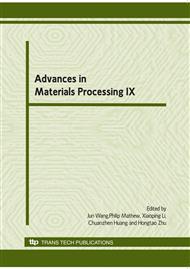p.582
p.588
p.596
p.602
p.608
p.614
p.620
p.626
p.631
Machining Properties of Insulating ZrO2 Ceramics Using Porous Copper Electrodes
Abstract:
Insulating ceramics were considered as machinable material with the electrical discharge machining method using the assisting electrode method, which was proposed and advanced by the authors. The mechanical properties changed with the experimental parameters, including the physical characteristics of the workpiece and the tool electrode. In this research, sintered ZrO2-Y2O3 insulating ceramics were subjected to EDM. To investigate the effects of the porous tool electrode material on the removal rate, the porous copper cylinder material was fabricated by PECS (pulse electric current sintering) method. The relative density changed from 60 to 95 wt%. The suitable machining characteristics could be obtained with a relative density of 85% at the positive electrode polarity. The shape of electrodes was transcribed on the workpiece surface more precisely than the solid copper electrode.
Info:
Periodical:
Pages:
608-613
Citation:
Online since:
June 2010
Authors:
Price:
Сopyright:
© 2010 Trans Tech Publications Ltd. All Rights Reserved
Share:
Citation:


